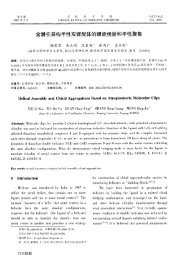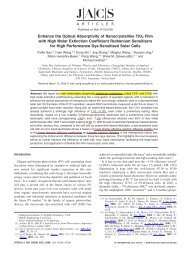Preparation of double-walled carbon nanotubes from fullerene ...
Preparation of double-walled carbon nanotubes from fullerene ...
Preparation of double-walled carbon nanotubes from fullerene ...
Create successful ePaper yourself
Turn your PDF publications into a flip-book with our unique Google optimized e-Paper software.
CARBON 48 (2010) 1312– 1320 1313<br />
and H 2 (2:1, v/v) at 300 Torr, and the gap between the electrodes<br />
was kept at ca. 2 mm during the arcing discharge. For<br />
each run, when FWS-derived anode with length <strong>of</strong> 3–4 cm<br />
was consumed, about 100–150 mg <strong>of</strong> DWCNTs film-like sticky<br />
deposite on the wire cage can be obtained.<br />
The as-obtained DWCNTs were examined using scanning<br />
electron microscope (SEM, JSM-6301F), transmission electron<br />
microscopy (TEM and HRTEM, Philips Tecnai G 2 20) and Raman<br />
spectroscopy (JY LabRam HR800 at 632.8 nm).<br />
The typical X-ray diffraction (XRD, Rigaku D/MAX 2400, Cu<br />
Ka, 40 kV and 100 mA) pr<strong>of</strong>ile <strong>of</strong> FWS-derived anode is shown<br />
in Fig. 1. The catalyst in the anode is Fe nanoparticles with<br />
diameters <strong>of</strong> ca. 40 nm that is estimated by Scherrer equation.<br />
From SEM image shown in Fig. 2a, lots <strong>of</strong> long filament-like<br />
material can be found in the as-obtained DWCNTs. These filaments<br />
entangle into nets with some catalyst nanoparticles<br />
Intensity (a.u.)<br />
•<br />
• Fe<br />
•<br />
10 20 30 40 50 60 70 80<br />
2 Theta<br />
Fig. 1 – XRD pr<strong>of</strong>ile <strong>of</strong> anode prepared <strong>from</strong> FWS.<br />
on the surface, as shown in Fig. 2b. Further HRTEM examination<br />
reveals that the filaments are DWCNT bundles, as shown<br />
in Fig. 2c and d, and the formation <strong>of</strong> bundles is believed to be<br />
due to the van der Waals interaction between individual<br />
<strong>nanotubes</strong> [8]. On average, the interlayer spacing between<br />
the inner and outer walls <strong>of</strong> the DWCNTs is ca. 0.4 nm, which<br />
is bigger than the interlayer spacing <strong>of</strong> MWCNTs and graphite.<br />
This may be due to the large repulsive force <strong>of</strong> the adjacent<br />
tube walls in DWCNTs [7]. It has been found that<br />
amorphous <strong>carbon</strong>s on the DWCNT bundles (see Fig. 2c and<br />
d) and most catalyst particles (see Fig. 2b) can be easily removed<br />
<strong>from</strong> the as-synthesized DWCNT samples through a<br />
purification process [6], resulting in high-purity DWCNT bundles,<br />
as evidenced in Fig. 2e.<br />
Raman spectroscopy is a powerful tool that is capable <strong>of</strong><br />
yielding more detailed information about DWCNT’s structure<br />
[7]. Fig. 3a shows a typical Raman spectrum <strong>of</strong> the as-prepared<br />
DWCNTs. For the as-prepared DWCNTs, the intensity<br />
ratio <strong>of</strong> G-band at 1593 cm 1 and D-band around 1323 cm 1 ,<br />
i.e., I G /I D is over 30, indicating that the DWCNT product contain<br />
little amorphous <strong>carbon</strong> and have well-developed graphitic<br />
structures.<br />
DWCNT is made <strong>of</strong> two coaxial SWCNTs. Because <strong>of</strong> this,<br />
the G-band <strong>of</strong> DWCNTs would be associated with vibration<br />
along the circumferential direction in the lower frequency<br />
range (G outer<br />
and G inner<br />
), and is also related to vibration along<br />
the direction <strong>of</strong> the nanotube axis in the higher frequency region<br />
(G + ) [8]. The G-band <strong>of</strong> the as-made DWCNTs shown in<br />
Fig. 3b can be fitted with Lorentzian peaks at 1594 cm 1 (G + ),<br />
1572 cm 1 (G outer<br />
), and the broad peak around 1540 (G inner<br />
)<br />
which are present due to existence <strong>of</strong> metallic tubes in the<br />
product, or due to the overlap <strong>of</strong> peaks <strong>of</strong> tubes with different<br />
Fig. 2 – (a) SEM image <strong>of</strong> raw product; (b) Low magnification TEM image <strong>of</strong> raw product; (c) and (d) HRTEM images <strong>of</strong> raw<br />
DWCNTs; (e) TEM image <strong>of</strong> the purified DWCNTs.
















